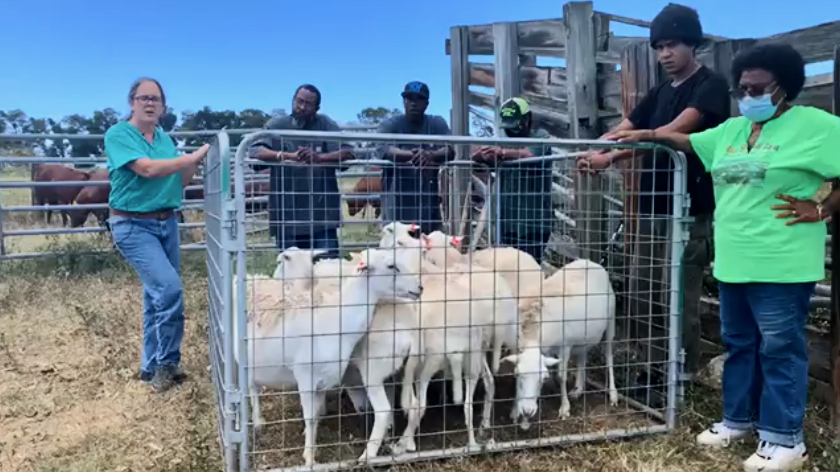
The Senepol cow and the St. Croix white hair sheep have been a part of U.S. Virgin Islands history since the 1800s, and on Thursday, veterinarian Bethany Bradford and her team discussed the legacy of the breeds during a livestreamed event from the Oscar E. Henry Farm Preserve.
Oscar Henry was the Agriculture commissioner under Gov. Juan F. Luis in the late 1970s and early ’80s and was known for progressing the agriculture industry in the U.S. Virgin Islands. His farm has been in existence for more than 60 years. The preserve is currently managed by Lavelle and Olivia Henry. At the farm, both the Senepol cow and the St. Croix white sheep are bred and preserved.
Bradford, the guest speaker, is the director of veterinary services for the territory for the Department of Agriculture.
She said the St. Croix white hair sheep are a tropical breed that can do well in hot humid conditions.
“They do well in a drought condition, which we often have here,” Bradford said.
The sheep have short hair, and some have rough backs that are considered their winter coat.
“These sheep have hair, not wool. Wool holds in heat,” said staff member Ayanna Simon. “Even though they are in the tropics it is wintertime, so the St. Croix white hair sheep naturally develop a thick saddle on their back that will shed.”
The breed of sheep has been shipped to all parts of the world as breeding stock. Recently, some were shipped to the Philippines because the island nation has a climate similar to the V.I. In 2001, some were shipped to Haiti to improve that country’s livestock herds.
“The Henry Farm was instrumental in maintaining the breed and keeping it pure, but also so that you are having consistent product … This is the point when you are breeding livestock,” Bradford said.

According to Bradford, Henry and his family have bred Senepol cattle for more than 60 years. Senepol is a combination of a couple of different breeds of cattle. In the 1800s, the Nelthropp family had a breed of cattle called the “N’Dama,” from Senegal, and is adapted to the tropical climate, unlike cattle bred for colder climates.
In the early 1900s, one of the Nelthropp’s wanted to improve that herd to increase milk production and other traits that he was interested in, which would allow him to provide a beef product locally and throughout the Caribbean. He brought in cattle called the Red Poll, which were developed in England in the late 19th century. The goal was to create a breed that was docile and had no horns so that they could be worked easily despite their large size, Bradford said. The Nelthropp’s were also looking for animals that are easy mothers and easy to give birth, do well in dryer weather and maintain good body weight and still produce meat. Their dark red color was also bred for, along with their ability to eat dry grass.
The combination of the N’Dama and the Red Poll resulted in the Senepol. That herd was sold to Annaly Farms and the Lawaetz family. Since then, they have been adamant about improving the breed and keeping the records.
“You want good conformation, meaning you want good legs on them, a good straight backline. You want good meat, a good filling out of the body, but you also want to know the records,” Bradford said.
Development of the Senepol on St Croix makes the breed an important part of V.I. history, Bradford said. The Senepol Association was set up in the 1970s and today you can find Senepol cattle in the United States and South America.
“They play an important role in providing protein as an excellent food source throughout the world, which is the point of livestock farming and why St. Croix is important for this,” Bradford said.
There are a few herds on the island besides those on the Oscar E. Henry Farm, including the University of the Virgin Islands and Annaly Farms.
“When you see the red cattle, you know they were developed here on St. Croix,” Bradford said.
“If you are watching us and you live in the United States, see if they are any St. Croix white sheep or Senepol cattle, they have gone all over the world. If you are here in the Virgin Islands when you see these animals have pride because these breeds were made right here for your people and for the people of the Caribbean, and that is something to be proud of,” said Simon.
Today 12,000 Senepol cattle and 4,000 St. Croix white sheep live in the U.S. Virgin Islands, she said.
“It is difficult to find people that are doing farm work these days. I would like to encourage any young person who is watching this program to see if they really enjoy working with these kinds of animals because it is a lost art,” said Lavelle Henry, one of the managers of the Oscar E. Henry Farm.
The presentation can be viewed on Facebook.





